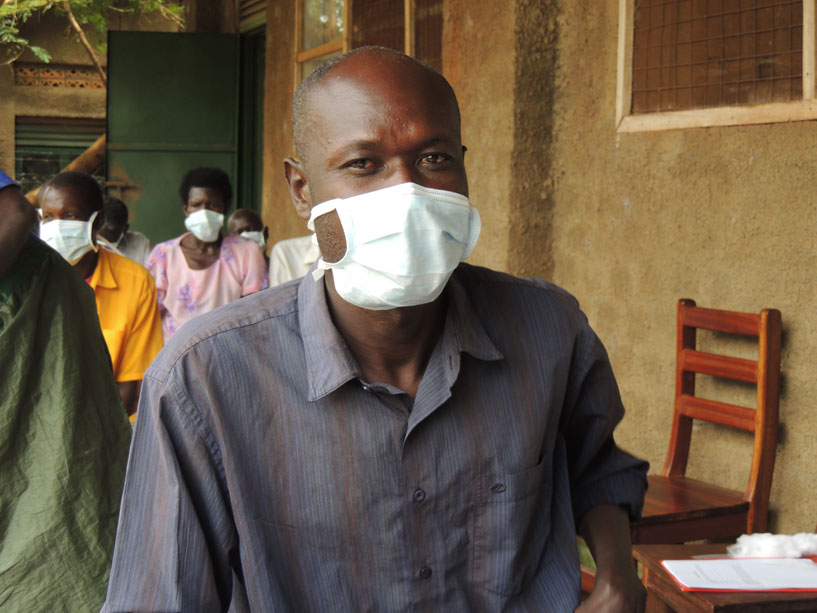Photo Essay: Linking Ugandan Communities to Tuberculosis Care
Photo Essay: Linking Ugandan Communities to Tuberculosis Care
Photos by Diana Tumuhairwe/MSH

Health workers throughout the developing world provide vital services and improve the lives of the people they serve, and yet they are often invisible. These men and women conduct community outreach, provide key prevention messages in the community, and deliver clinical care, treatment, and follow-up. In Uganda, the USAID TRACK TB project, MSH, supports 52 community linkage facilitators to help increase tuberculosis (TB) case detection and treatment success rates.
As their name suggests, they serve as the link between the patient and the health facility. The facilitators receive a monthly allowance, mobile phones, paid airtime, and transportation reimbursement as they track treatment adherence of TB patients in and around Kampala, Uganda’s capital. The facilitators are critical to the successful implementation of the World Health Organization’s DOTS (directly observed treatment short-course) strategy, which helps patients adhere to treatment.
If patients stop taking their medication, they can develop drug-resistant TB, which threatens to reverse the global progress made in TB care and control. In addition, patients on treatment are less infectious.
The following photos illustrate the work of linkage facilitators in and around Kampala.
![[In this photo, community linkage facilitator Mary Nkinza (right) tracks a TB patient’s adherence to treatment by reviewing the card that the patient is supposed to update after taking her medicine. Nkinza and other facilitators communicate with patients through text messages, phone calls, and regular visits. Facilitators receive on-the-job training and are chosen based on their previous experience in providing community health services. Each facilitator tracks up to 15 patients, depending on how many are registered at the health facility assigned to support the facilitator.] {Photo credit: Diana Tumuhairwe/MSH}](https://prevsite.msh.org/sites/msh.org/files/dt_tracktb_1_web624x439.jpg)
In this photo, community linkage facilitator Mary Nkinza (right) tracks a TB patient’s adherence to treatment by reviewing the card that the patient is supposed to update after taking her medicine. Nkinza and other facilitators communicate with patients through text messages, phone calls, and regular visits. Facilitators receive on-the-job training and are chosen based on their previous experience in providing community health services. Each facilitator tracks up to 15 patients, depending on how many are registered at the health facility assigned to support the facilitator.
![[Facilitator David Kaliisa meets with a patient in the Kawempe area of Kampala as she shows him her medication. An urban slum, Kawempe has a high concentration of TB cases. This patient’s 12-year-old daughter is on treatment as well. The facilitators also monitor contacts of patients for signs of infection, such as coughing, night fevers, and weight loss. Facilitators advise patients to keep windows open in their homes to allow air to circulate, which decreases the likelihood of spreading the infection to others in the home.] {Photo credit: Diana Tumuhairwe/MSH}](https://prevsite.msh.org/sites/msh.org/files/dt_tracktb_2_web625.jpg)
Facilitator David Kaliisa meets with a patient in the Kawempe area of Kampala as she shows him her medication. An urban slum, Kawempe has a high concentration of TB cases. This patient’s 12-year-old daughter is on treatment as well. The facilitators also monitor the contacts of patients for signs of infection, such as coughing, night fevers, and weight loss. Facilitators advise patients to keep windows open in their homes to allow air to circulate, which decreases the likelihood of spreading the infection to others in the home.
![[In addition to visiting the homes of TB patients, facilitators conduct community outreach to disseminate information about TB, provide counseling, and screen for the disease. In the photo above, a facilitator discusses the warning signs of TB with members of an urban police barracks.] {Photo credit: Diana Tumuhairwe/MSH}](https://prevsite.msh.org/sites/msh.org/files/dt_tracktb_3_web.jpg)
In addition to visiting the homes of TB patients, facilitators conduct community outreach to disseminate information about TB, provide counseling, and screen for the disease. In the photo above, a facilitator discusses the warning signs of TB with members of an urban police barracks.
![[Facilitators also collect sputum samples and take them to their supporting facilities for testing. This facilitator has collected a sample from a community member and is directing her to the next step in the process.] {Photo credit: Diana Tumuhairwe/MSH}](https://prevsite.msh.org/sites/msh.org/files/dt_tracktb_4_web.jpg)
Facilitators also collect sputum samples and take them to their supporting facilities for testing. This facilitator has collected a sample from a community member and is directing her to the next step in the process.
![[Pediatric TB is widely underdiagnosed in the developing world and efforts are underway to expand screening of children in Uganda and elsewhere. Here, a father waits as a facilitator speaks with his daughter, who he said had developed a cough. The linkage facilitators have already helped make a profound difference in and around Kampala. Their patient support and tracking activities have contributed to TRACK TB treatment success rates of 85 percent so far this year, up from 71 percent in 2013. The number of patients who have been lost to follow-up – when they can no longer be tracked for various reasons – decreased from 26 percent in 2013 to 4.8 percent this year.] {Photo credit: Diana Tumuhairwe/MSH}](https://prevsite.msh.org/sites/msh.org/files/dt_tracktb_5_web624.jpg)
Pediatric TB is widely underdiagnosed in the developing world and efforts are underway to expand screening of children in Uganda and elsewhere. Here, a father waits as a facilitator speaks with his daughter, who he said had developed a cough. The linkage facilitators have already helped make a profound difference in and around Kampala. Their patient support and tracking activities have contributed to TRACK TB treatment success rates of 85 percent so far this year, up from 71 percent in 2013. The number of patients who have been lost to follow-up – when they can no longer be tracked for various reasons – decreased from 26 percent in 2013 to 4.8 percent this year.
TRACK TB works in partnership with the nongovernmental organization AIDS Information Center-Uganda (AIC). The five-year project (2013-2017) implements activities in Kampala, provides specific support to the central National TB and Leprosy Control Programme, and provides technical assistance to district-based USAID-funded partners in Uganda’s four regions.